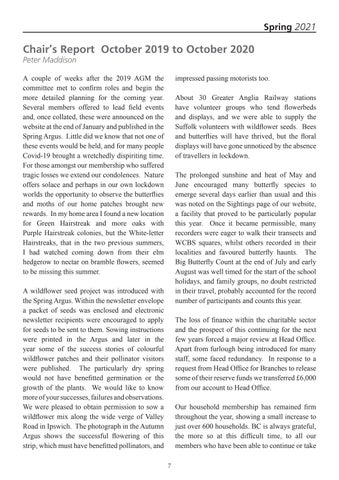Spring 2021
Chair’s Report October 2019 to October 2020 Peter Maddison
A couple of weeks after the 2019 AGM the committee met to confirm roles and begin the more detailed planning for the coming year. Several members offered to lead field events and, once collated, these were announced on the website at the end of January and published in the Spring Argus. Little did we know that not one of these events would be held, and for many people Covid-19 brought a wretchedly dispiriting time. For those amongst our membership who suffered tragic losses we extend our condolences. Nature offers solace and perhaps in our own lockdown worlds the opportunity to observe the butterflies and moths of our home patches brought new rewards. In my home area I found a new location for Green Hairstreak and more oaks with Purple Hairstreak colonies, but the White-letter Hairstreaks, that in the two previous summers, I had watched coming down from their elm hedgerow to nectar on bramble flowers, seemed to be missing this summer.
impressed passing motorists too. About 30 Greater Anglia Railway stations have volunteer groups who tend flowerbeds and displays, and we were able to supply the Suffolk volunteers with wildflower seeds. Bees and butterflies will have thrived, but the floral displays will have gone unnoticed by the absence of travellers in lockdown. The prolonged sunshine and heat of May and June encouraged many butterfly species to emerge several days earlier than usual and this was noted on the Sightings page of our website, a facility that proved to be particularly popular this year. Once it became permissible, many recorders were eager to walk their transects and WCBS squares, whilst others recorded in their localities and favoured butterfly haunts. The Big Butterfly Count at the end of July and early August was well timed for the start of the school holidays, and family groups, no doubt restricted in their travel, probably accounted for the record number of participants and counts this year.
A wildflower seed project was introduced with the Spring Argus. Within the newsletter envelope a packet of seeds was enclosed and electronic newsletter recipients were encouraged to apply for seeds to be sent to them. Sowing instructions were printed in the Argus and later in the year some of the success stories of colourful wildflower patches and their pollinator visitors were published. The particularly dry spring would not have benefitted germination or the growth of the plants. We would like to know more of your successes, failures and observations. We were pleased to obtain permission to sow a wildflower mix along the wide verge of Valley Road in Ipswich. The photograph in the Autumn Argus shows the successful flowering of this strip, which must have benefitted pollinators, and
The loss of finance within the charitable sector and the prospect of this continuing for the next few years forced a major review at Head Office. Apart from furlough being introduced for many staff, some faced redundancy. In response to a request from Head Office for Branches to release some of their reserve funds we transferred £6,000 from our account to Head Office. Our household membership has remained firm throughout the year, showing a small increase to just over 600 households. BC is always grateful, the more so at this difficult time, to all our members who have been able to continue or take 7







